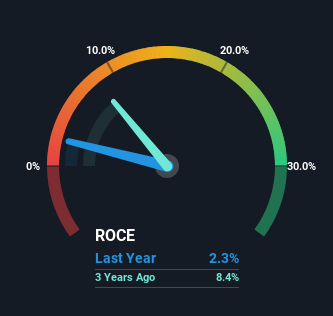
If we want to find a stock that could multiply over the long term, what are the underlying trends we should look for? Firstly, we'd want to identify a growing return on capital employed (ROCE) and then alongside that, an ever-increasing base of capital employed. Put simply, these types of businesses are compounding machines, meaning they are continually reinvesting their earnings at ever-higher rates of return. Having said that, from a first glance at Birla (NSE:BIRLACORPN) we aren't jumping out of our chairs at how returns are trending, but let's have a deeper look.
What Is Return On Capital Employed (ROCE)?
For those who don't know, ROCE is a measure of a company's yearly pre-tax profit (its return), relative to the capital employed in the business. To calculate this metric for Birla, this is the formula:
Return on Capital Employed = Earnings Before Interest and Tax (EBIT) ÷ (Total Assets - Current Liabilities)
0.023 = ₹2.7b ÷ (₹141b - ₹23b) (Based on the trailing twelve months to June 2023).
Therefore, Birla has an ROCE of 2.3%. In absolute terms, that's a low return and it also under-performs the Basic Materials industry average of 6.7%.
See our latest analysis for Birla

In the above chart we have measured Birla's prior ROCE against its prior performance, but the future is arguably more important. If you'd like to see what analysts are forecasting going forward, you should check out our free report for Birla.
So How Is Birla's ROCE Trending?
On the surface, the trend of ROCE at Birla doesn't inspire confidence. Over the last five years, returns on capital have decreased to 2.3% from 5.2% five years ago. Although, given both revenue and the amount of assets employed in the business have increased, it could suggest the company is investing in growth, and the extra capital has led to a short-term reduction in ROCE. If these investments prove successful, this can bode very well for long term stock performance.
The Key Takeaway
In summary, despite lower returns in the short term, we're encouraged to see that Birla is reinvesting for growth and has higher sales as a result. And long term investors must be optimistic going forward because the stock has returned a huge 120% to shareholders in the last five years. So should these growth trends continue, we'd be optimistic on the stock going forward.
On a final note, we found 3 warning signs for Birla (1 shouldn't be ignored) you should be aware of.
If you want to search for solid companies with great earnings, check out this free list of companies with good balance sheets and impressive returns on equity.
Valuation is complex, but we're here to simplify it.
Discover if Birla might be undervalued or overvalued with our detailed analysis, featuring fair value estimates, potential risks, dividends, insider trades, and its financial condition.
Access Free AnalysisHave feedback on this article? Concerned about the content? Get in touch with us directly. Alternatively, email editorial-team (at) simplywallst.com.
This article by Simply Wall St is general in nature. We provide commentary based on historical data and analyst forecasts only using an unbiased methodology and our articles are not intended to be financial advice. It does not constitute a recommendation to buy or sell any stock, and does not take account of your objectives, or your financial situation. We aim to bring you long-term focused analysis driven by fundamental data. Note that our analysis may not factor in the latest price-sensitive company announcements or qualitative material. Simply Wall St has no position in any stocks mentioned.
About NSEI:BIRLACORPN
Birla
Manufactures and sells cement and clinker in India and internationally.
Adequate balance sheet average dividend payer.
Similar Companies
Market Insights
Community Narratives





